Mobile Application for Admin-User Communication
Added on 2023-04-25
31 Pages9126 Words121 Views
Running head: MOBILE APPLICATION THAT COMMUNICATES BETWEEN AN ADMIN
AND USERS
Mobile application that communicates between an admin and users
Name of the Student
Name of the University
AND USERS
Mobile application that communicates between an admin and users
Name of the Student
Name of the University
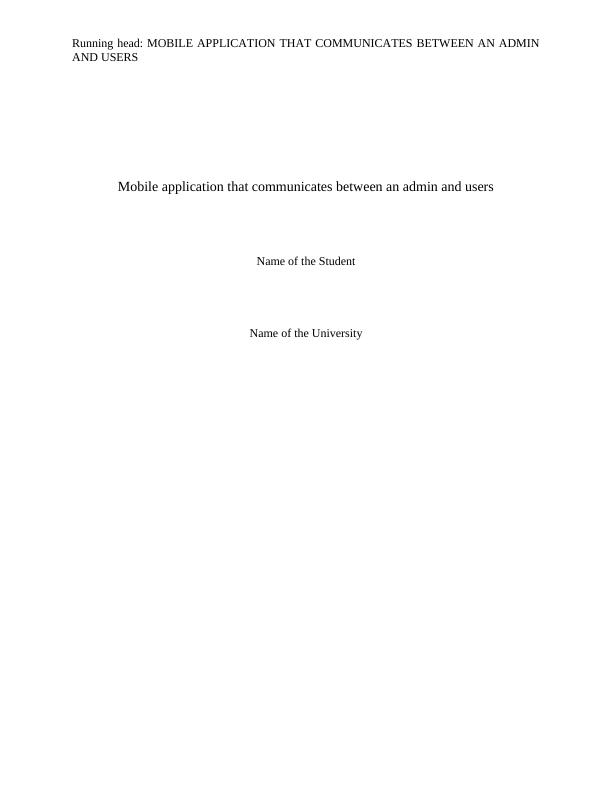
2
MOBILE APPLICATION THAT COMMUNICATES BETWEEN AN ADMIN AND
USERS
Abstract
This report has been based on the concept of mobile application development. The concept of
mobile communication has been discussed in the report. The history of mobile communication
has been analyzed in the report. A mobile application has been helping in providing end-users for
accessing Internet anytime and anywhere. Users can access data and information that are stored
on shared devices over wireless networks. Mobile applications refers to a type of software
application that are developed to run on mobile device including smartphones and tablets. There
has been comparison of different similar mobile application have been done. Xamarin studio has
been analyzed as an alternative for android studio. The difference between Azure database and
MySQL database has been provided in the report.
MOBILE APPLICATION THAT COMMUNICATES BETWEEN AN ADMIN AND
USERS
Abstract
This report has been based on the concept of mobile application development. The concept of
mobile communication has been discussed in the report. The history of mobile communication
has been analyzed in the report. A mobile application has been helping in providing end-users for
accessing Internet anytime and anywhere. Users can access data and information that are stored
on shared devices over wireless networks. Mobile applications refers to a type of software
application that are developed to run on mobile device including smartphones and tablets. There
has been comparison of different similar mobile application have been done. Xamarin studio has
been analyzed as an alternative for android studio. The difference between Azure database and
MySQL database has been provided in the report.
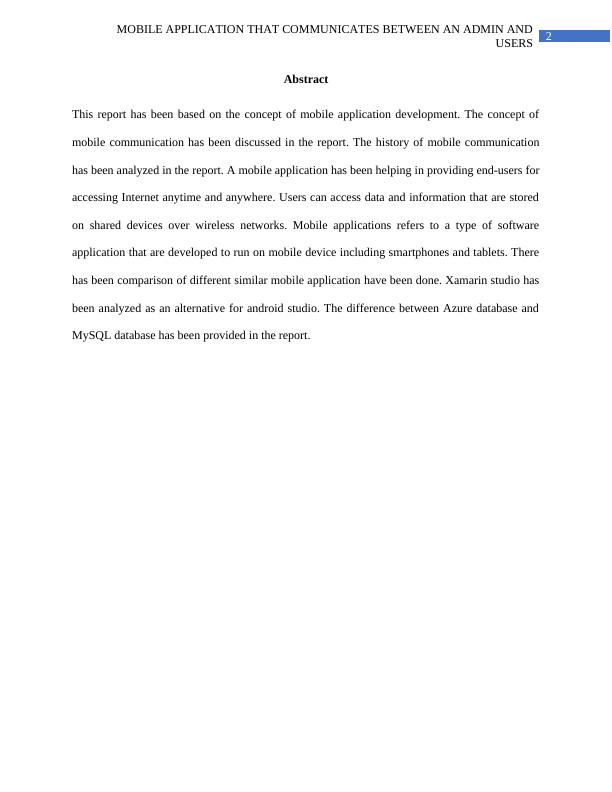
3
MOBILE APPLICATION THAT COMMUNICATES BETWEEN AN ADMIN AND
USERS
Table of Contents
Chapter 1: Introduction....................................................................................................................4
1.1 Concept of Mobile Communication..................................................................................4
1.2 History of mobile communication....................................................................................6
Chapter 2: Literature Review.........................................................................................................10
Chapter 3: Research Methodology................................................................................................16
Comparison between Xamarin and Android Studio..................................................................19
References......................................................................................................................................26
MOBILE APPLICATION THAT COMMUNICATES BETWEEN AN ADMIN AND
USERS
Table of Contents
Chapter 1: Introduction....................................................................................................................4
1.1 Concept of Mobile Communication..................................................................................4
1.2 History of mobile communication....................................................................................6
Chapter 2: Literature Review.........................................................................................................10
Chapter 3: Research Methodology................................................................................................16
Comparison between Xamarin and Android Studio..................................................................19
References......................................................................................................................................26
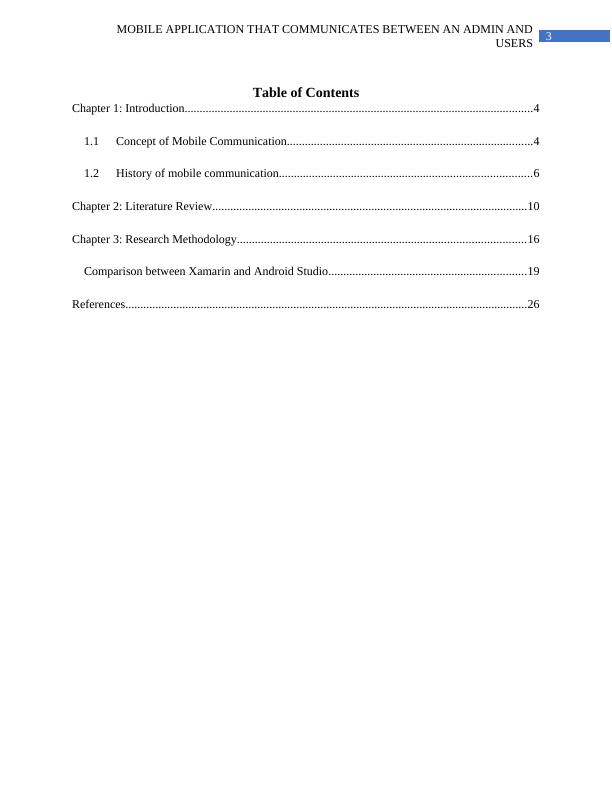
4
MOBILE APPLICATION THAT COMMUNICATES BETWEEN AN ADMIN AND
USERS
Chapter 1: Introduction
1.1 Concept of Mobile Communication
Wireless Communication has been one of the fastest growing technology in the recent years.
One of the major applications of wireless technology has been mobile communications. Mobile
communication have been efficiently increasing its demand among users. Mobile phones have
been used widely all over the world. There have been increase in the mobile phone users. As
commented by (Hu et al. 2015), the number of mobile phone users in 1984, 1994 and 1997 have
been 25 thousand, 16 million and 50 million respectively. Therefore, it can be seen that there
have been huge increase in popularity of mobile phone users across the world. The objectives of
mobile phones have not been stuck to only voice calls. Innovation in technology and internet
have increased the usability of mobile phones to other purposes. Most of the work are done using
mobile phones including voice calls, video calls, messaging, clicking photos, email and various
other purposes. Therefore, an individual can connect with the work using a mobile phone. There
have been various applications available that support interaction between admin and users of
mobile phones. Mobile phones have been hoeing in providing proper approach to the
development of the society in various ways (Chen et al. 2015). Mobile phones have become very
popular among users. The latest smart phones contains various type of sensors and artificial
intelligence systems that help in providing different types of security and ease to use the mobile
phone.
A mobile application has typically two components including running on mobile device
of user and communicates over a wireless data transmission network with another component
that executes in an application serverTraditionally, various mobile application s have been
MOBILE APPLICATION THAT COMMUNICATES BETWEEN AN ADMIN AND
USERS
Chapter 1: Introduction
1.1 Concept of Mobile Communication
Wireless Communication has been one of the fastest growing technology in the recent years.
One of the major applications of wireless technology has been mobile communications. Mobile
communication have been efficiently increasing its demand among users. Mobile phones have
been used widely all over the world. There have been increase in the mobile phone users. As
commented by (Hu et al. 2015), the number of mobile phone users in 1984, 1994 and 1997 have
been 25 thousand, 16 million and 50 million respectively. Therefore, it can be seen that there
have been huge increase in popularity of mobile phone users across the world. The objectives of
mobile phones have not been stuck to only voice calls. Innovation in technology and internet
have increased the usability of mobile phones to other purposes. Most of the work are done using
mobile phones including voice calls, video calls, messaging, clicking photos, email and various
other purposes. Therefore, an individual can connect with the work using a mobile phone. There
have been various applications available that support interaction between admin and users of
mobile phones. Mobile phones have been hoeing in providing proper approach to the
development of the society in various ways (Chen et al. 2015). Mobile phones have become very
popular among users. The latest smart phones contains various type of sensors and artificial
intelligence systems that help in providing different types of security and ease to use the mobile
phone.
A mobile application has typically two components including running on mobile device
of user and communicates over a wireless data transmission network with another component
that executes in an application serverTraditionally, various mobile application s have been

5
MOBILE APPLICATION THAT COMMUNICATES BETWEEN AN ADMIN AND
USERS
reflecting similar type of services to users (Flores et al. 2015). In recent years, mobile devices
have been sharing various unique features of mobile devices. There have been different type of
applications present in smart phones. Mobile applications have been first popularized by Apple
by App Store and then followed by Google Play Store. In recent years, there have been huge
number of applications including 1.2 to 1.4 million applications (Talavera et al. 2015).
Figure 1: Number of Apps Available in Leading App Stores 2014
(Source: Tullberg et al. 2016)
The above graph shows that most of the applications are available over Google Play Store
and Apple App Store. This has been helping in providing a better opportunity for mobile
communication system in future. The online applications have been helping in various sector
including healthcare, games, entertainment, food and travel industry. Now a days, most of the
applications are interactive applications. Mobile applications have been helping in quick
communication with users and customers in the market. The interface of the mobile applications
have been user friendly that helps in proper utilization of themes. This has been helping in
MOBILE APPLICATION THAT COMMUNICATES BETWEEN AN ADMIN AND
USERS
reflecting similar type of services to users (Flores et al. 2015). In recent years, mobile devices
have been sharing various unique features of mobile devices. There have been different type of
applications present in smart phones. Mobile applications have been first popularized by Apple
by App Store and then followed by Google Play Store. In recent years, there have been huge
number of applications including 1.2 to 1.4 million applications (Talavera et al. 2015).
Figure 1: Number of Apps Available in Leading App Stores 2014
(Source: Tullberg et al. 2016)
The above graph shows that most of the applications are available over Google Play Store
and Apple App Store. This has been helping in providing a better opportunity for mobile
communication system in future. The online applications have been helping in various sector
including healthcare, games, entertainment, food and travel industry. Now a days, most of the
applications are interactive applications. Mobile applications have been helping in quick
communication with users and customers in the market. The interface of the mobile applications
have been user friendly that helps in proper utilization of themes. This has been helping in
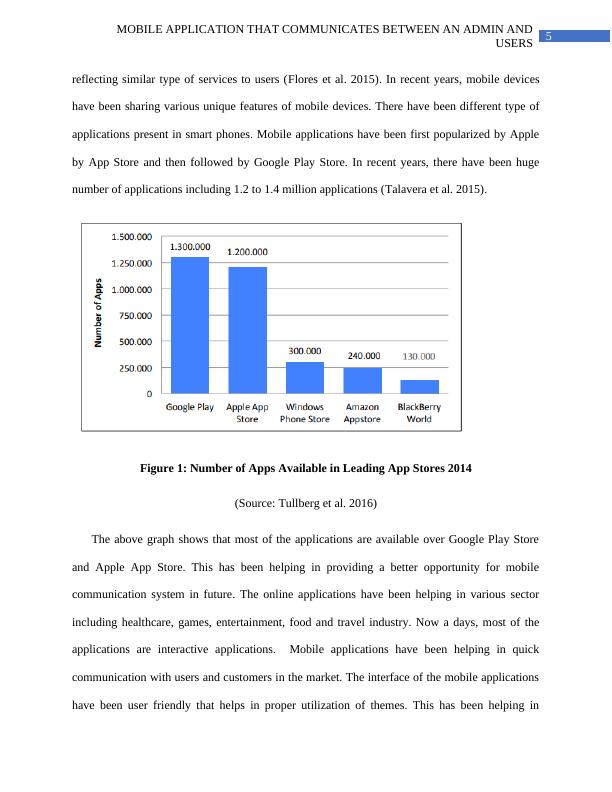
6
MOBILE APPLICATION THAT COMMUNICATES BETWEEN AN ADMIN AND
USERS
maintaining a keen approach in the development of companies. Most of the users have been
using smart phones in the market. Therefore, it becomes easy for the companies to research to
the customers with the help of mobile applications. Interactive mobile applications have been
helping in directly communicate with the customers by companies. Mobile phones have become
very popular among users (Tullberg et al. 2016). The latest smart phones contains various type of
sensors and artificial intelligence systems that help in providing different types of security and
ease to use the mobile phone. There have been interactions between users and admin. It means
that admin and directly get in contact with users with the help of the applications. Therefore, it
can be seen that there have been huge increase in the popularity of mobile phone users across the
world. The objectives of mobile phones have not been stuck to only voice calls. It also helps in
saving tome in communication and increasing productivity of the company. It has been helping
in improving IT infrastructure in developing countries. There has been various benefits of
mobile communication discussed in this study. This study has been focused on analyzing mobile
application that enables interactive communication between admin and users.
1.2 History of mobile communication
Cellular technology has been acquired over three generations since 1979. The first cellular
network was designed in Japan. The first generation (1G) of cellular was analog network that is
completely analog network and used for voice calls only. These phones have been used only for
one purpose including voice calls. The second generation (2G) has been a digital network and
helps in providing digital services. The third generation (3G) cellular network allowing high-
speed data along with voice (Akaiwa 2015). Therefore, the third generation of the mobile
communication has been able to use both voice and data calls along with. The 3G network has
been able to involve features including packet switched data and information services. The use of
MOBILE APPLICATION THAT COMMUNICATES BETWEEN AN ADMIN AND
USERS
maintaining a keen approach in the development of companies. Most of the users have been
using smart phones in the market. Therefore, it becomes easy for the companies to research to
the customers with the help of mobile applications. Interactive mobile applications have been
helping in directly communicate with the customers by companies. Mobile phones have become
very popular among users (Tullberg et al. 2016). The latest smart phones contains various type of
sensors and artificial intelligence systems that help in providing different types of security and
ease to use the mobile phone. There have been interactions between users and admin. It means
that admin and directly get in contact with users with the help of the applications. Therefore, it
can be seen that there have been huge increase in the popularity of mobile phone users across the
world. The objectives of mobile phones have not been stuck to only voice calls. It also helps in
saving tome in communication and increasing productivity of the company. It has been helping
in improving IT infrastructure in developing countries. There has been various benefits of
mobile communication discussed in this study. This study has been focused on analyzing mobile
application that enables interactive communication between admin and users.
1.2 History of mobile communication
Cellular technology has been acquired over three generations since 1979. The first cellular
network was designed in Japan. The first generation (1G) of cellular was analog network that is
completely analog network and used for voice calls only. These phones have been used only for
one purpose including voice calls. The second generation (2G) has been a digital network and
helps in providing digital services. The third generation (3G) cellular network allowing high-
speed data along with voice (Akaiwa 2015). Therefore, the third generation of the mobile
communication has been able to use both voice and data calls along with. The 3G network has
been able to involve features including packet switched data and information services. The use of
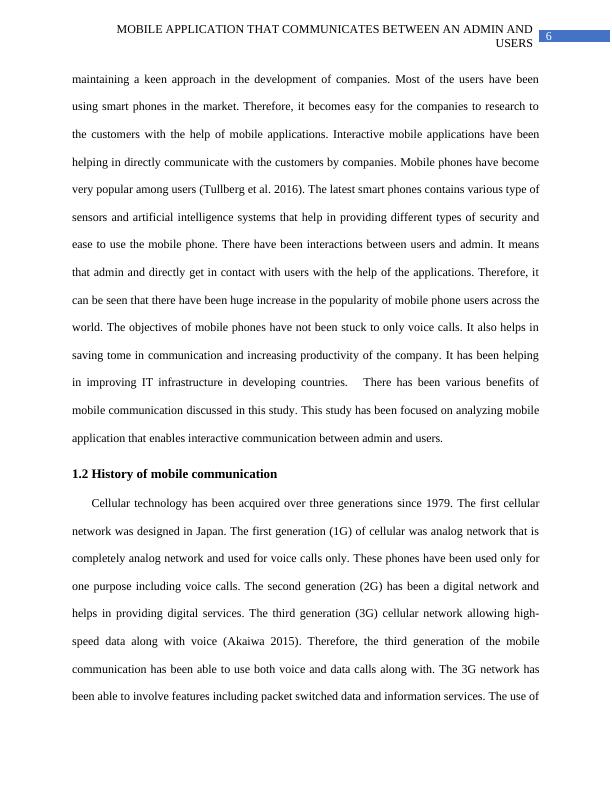
7
MOBILE APPLICATION THAT COMMUNICATES BETWEEN AN ADMIN AND
USERS
data services has been helping in providing proper roaming services in the calls. The fourth
generation (4G) has been providing enhanced speed if data services of mobile communication.
First Generation (1G) of Mobile Communication
The first generation of mobile phone devices have been developed in 1979 in Japan. This
network has used analog circuit switched technology with proper Frequency Division Multiple
Access (FDMA) as air channel multiple access technique and worked mainly in the 800-900
MHz frequency bands. The 1G mobile device had only voice transmission. For example, Total
Access Communication System (TACS) and Analog Mobile Phone System (AMPS) (Imai et al.
2015). There have been various limitations of 1G technology including supporting only speech,
low traffic capacity, long call setup time and frequent call drops. There have been insufficient
use of bandwidth with poor battery life. The quality of voice in the 1G has been very poor and
size of phone has been large.
Second Generation (2G) of mobile communication
There has been increase in the demand of mobile phones after the evolution of 1G
network. Therefore, second generation (2G) has been developed in early 1990s. This can be
divided into two types including Time Division Multiple Access (TDMA) and Code Division
Multiple Access (CDMA). The first commercial digital cellular system has been Global System
for Mobile (GSM) and applications in TDMA. The frequency bands that are used in CDMA has
been 890-960 Hz and 1710-1880 MHz. In the 890-960 MHz frequency band, the band at 890-
915 MHz has been dedicated to uplink communication from mobile station to base station (Li et
al. 2016). The 2G systems employ digital modulation and advanced call processing abilities.
There have been various advantages of 2g network technology including small battery size that
MOBILE APPLICATION THAT COMMUNICATES BETWEEN AN ADMIN AND
USERS
data services has been helping in providing proper roaming services in the calls. The fourth
generation (4G) has been providing enhanced speed if data services of mobile communication.
First Generation (1G) of Mobile Communication
The first generation of mobile phone devices have been developed in 1979 in Japan. This
network has used analog circuit switched technology with proper Frequency Division Multiple
Access (FDMA) as air channel multiple access technique and worked mainly in the 800-900
MHz frequency bands. The 1G mobile device had only voice transmission. For example, Total
Access Communication System (TACS) and Analog Mobile Phone System (AMPS) (Imai et al.
2015). There have been various limitations of 1G technology including supporting only speech,
low traffic capacity, long call setup time and frequent call drops. There have been insufficient
use of bandwidth with poor battery life. The quality of voice in the 1G has been very poor and
size of phone has been large.
Second Generation (2G) of mobile communication
There has been increase in the demand of mobile phones after the evolution of 1G
network. Therefore, second generation (2G) has been developed in early 1990s. This can be
divided into two types including Time Division Multiple Access (TDMA) and Code Division
Multiple Access (CDMA). The first commercial digital cellular system has been Global System
for Mobile (GSM) and applications in TDMA. The frequency bands that are used in CDMA has
been 890-960 Hz and 1710-1880 MHz. In the 890-960 MHz frequency band, the band at 890-
915 MHz has been dedicated to uplink communication from mobile station to base station (Li et
al. 2016). The 2G systems employ digital modulation and advanced call processing abilities.
There have been various advantages of 2g network technology including small battery size that
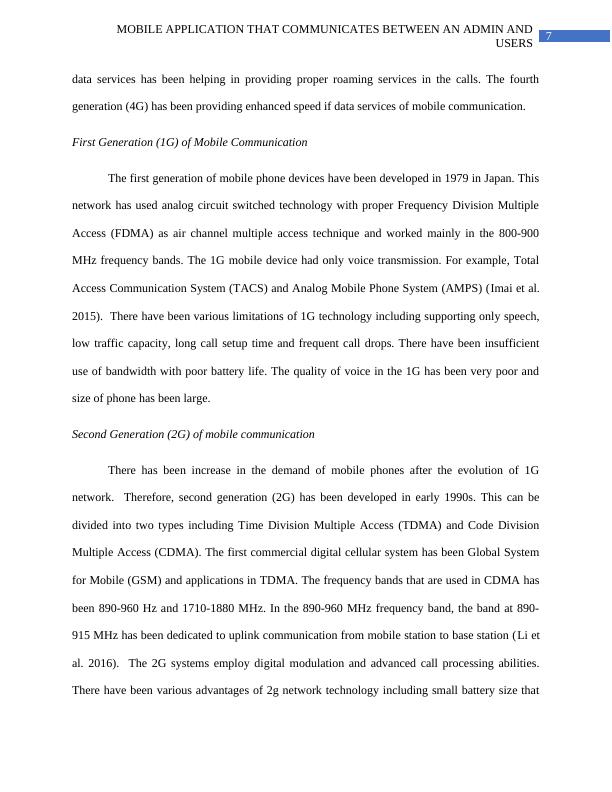
8
MOBILE APPLICATION THAT COMMUNICATES BETWEEN AN ADMIN AND
USERS
helps in less battery power usage. The voice quality has been improved from 1G technology.
Digital signal and voice data has been multiplexed, compressed and encrypted efficiently than
analog voice data. Digital voice encoding system has been allowing handling digital error
checking that can boost-up sound quality. The major benefit of 2G technology is that the location
of mobile user can be traced easily (Oppegaard and Rabby 2016).
However, there are some limitations of 2G technology including lower data rates ranging
from 9.6 Kbps to 28.8 Kbps. In rural areas, the digital signal have been weaker and not enough
or reaching to a mobile cell tower. However, there have been a rare problem in the 2G has been
deployed on very high frequency and low power.
Third generation (3G) of mobile communication
The development and need of high speed internet access, live video conferencing and
simultaneous data with voice transmission have given rise to 3G cellular networks. 3G
technology has been adding multimedia facilities to mobile phones. It has been operating in
frequency band of 1710-2170 MHz. It helps in providing high transmission rates of 348 Kbps for
a moving vehicle to 2 Mbps for stationary or walking users. The aim of 3G systems has been
providing communication services from person to person at any place. The main objectives of
3G systems have been supporting 2 Mbps for handle held devices, 384 Kbps for walking devices
and 144 Kbps for car-borne mobile devices (Sharma et al. 2017). The 3G system need to work
on all radio environments including urban areas, suburban areas, hilly and mountainous regions
and indoor environments.
Fourth generation (4G) of mobile communication
MOBILE APPLICATION THAT COMMUNICATES BETWEEN AN ADMIN AND
USERS
helps in less battery power usage. The voice quality has been improved from 1G technology.
Digital signal and voice data has been multiplexed, compressed and encrypted efficiently than
analog voice data. Digital voice encoding system has been allowing handling digital error
checking that can boost-up sound quality. The major benefit of 2G technology is that the location
of mobile user can be traced easily (Oppegaard and Rabby 2016).
However, there are some limitations of 2G technology including lower data rates ranging
from 9.6 Kbps to 28.8 Kbps. In rural areas, the digital signal have been weaker and not enough
or reaching to a mobile cell tower. However, there have been a rare problem in the 2G has been
deployed on very high frequency and low power.
Third generation (3G) of mobile communication
The development and need of high speed internet access, live video conferencing and
simultaneous data with voice transmission have given rise to 3G cellular networks. 3G
technology has been adding multimedia facilities to mobile phones. It has been operating in
frequency band of 1710-2170 MHz. It helps in providing high transmission rates of 348 Kbps for
a moving vehicle to 2 Mbps for stationary or walking users. The aim of 3G systems has been
providing communication services from person to person at any place. The main objectives of
3G systems have been supporting 2 Mbps for handle held devices, 384 Kbps for walking devices
and 144 Kbps for car-borne mobile devices (Sharma et al. 2017). The 3G system need to work
on all radio environments including urban areas, suburban areas, hilly and mountainous regions
and indoor environments.
Fourth generation (4G) of mobile communication
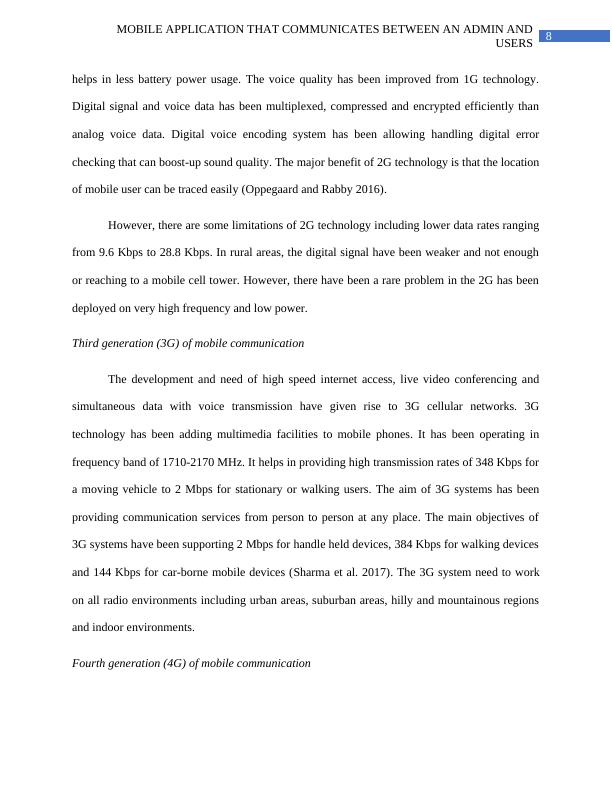
End of preview
Want to access all the pages? Upload your documents or become a member.
Related Documents
Wireless Networking for Library Management Systemlg...
|13
|830
|474
Mobile Business Solution: A Comparison of Android and iOS Platformslg...
|9
|2232
|433
Wireless and Mobile Communication: Advantages, Disadvantages and Recommendationslg...
|9
|1599
|193
Impacts of Mobile Technologies on Studentslg...
|5
|3070
|236
Impact of Mobile Gaming on Users: Addiction and Health Effectslg...
|8
|3265
|156
Operating System of Android Phoneslg...
|4
|808
|198
